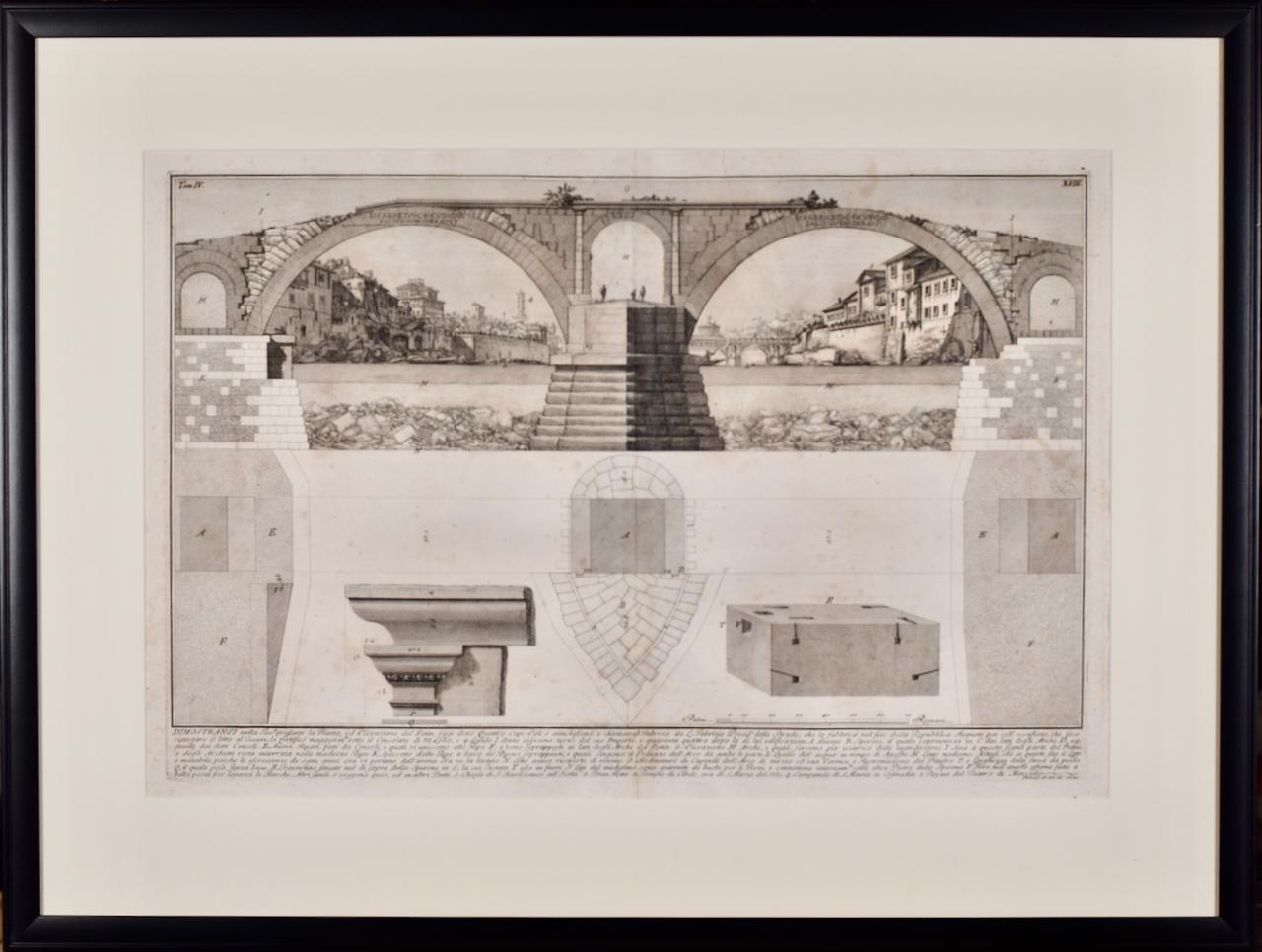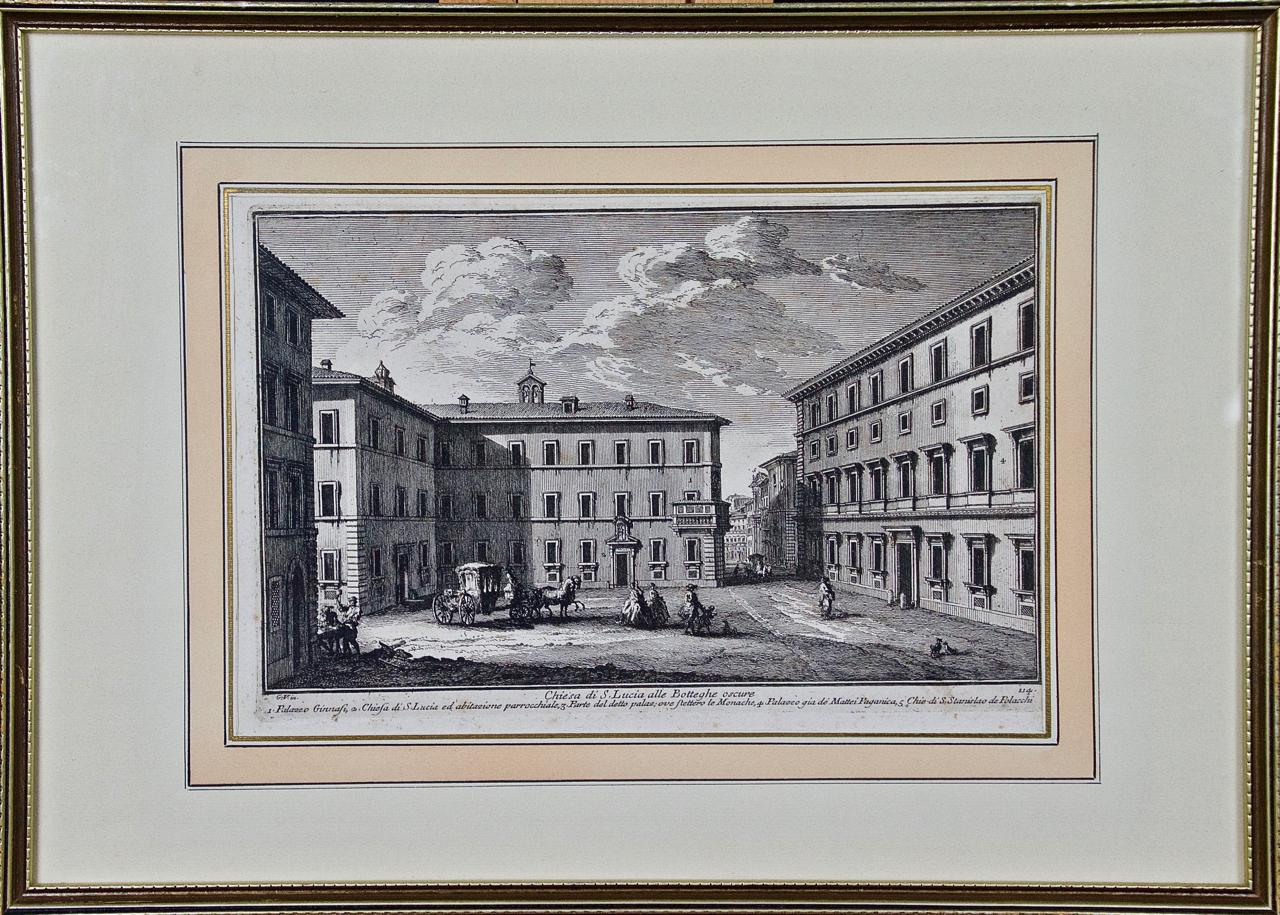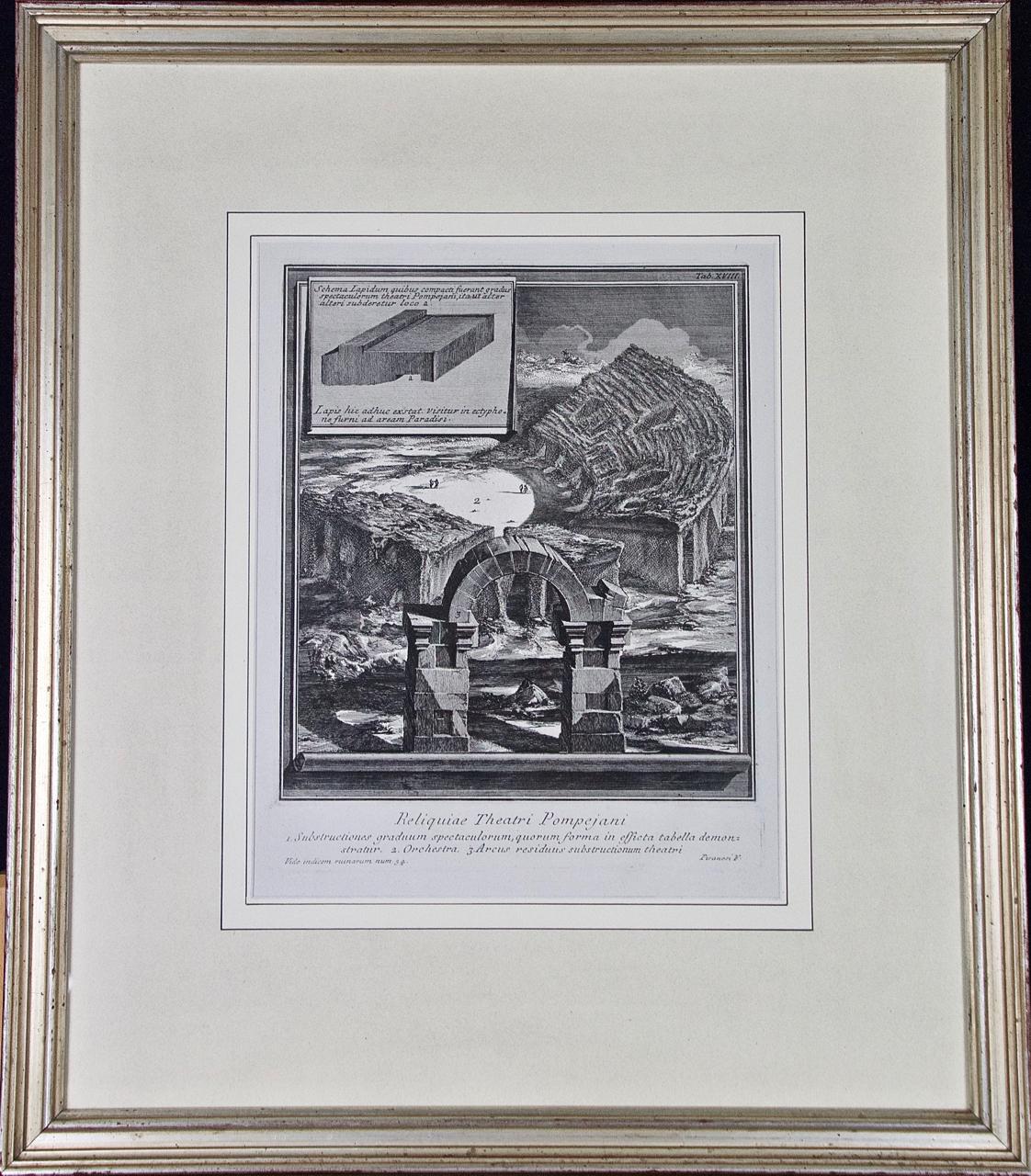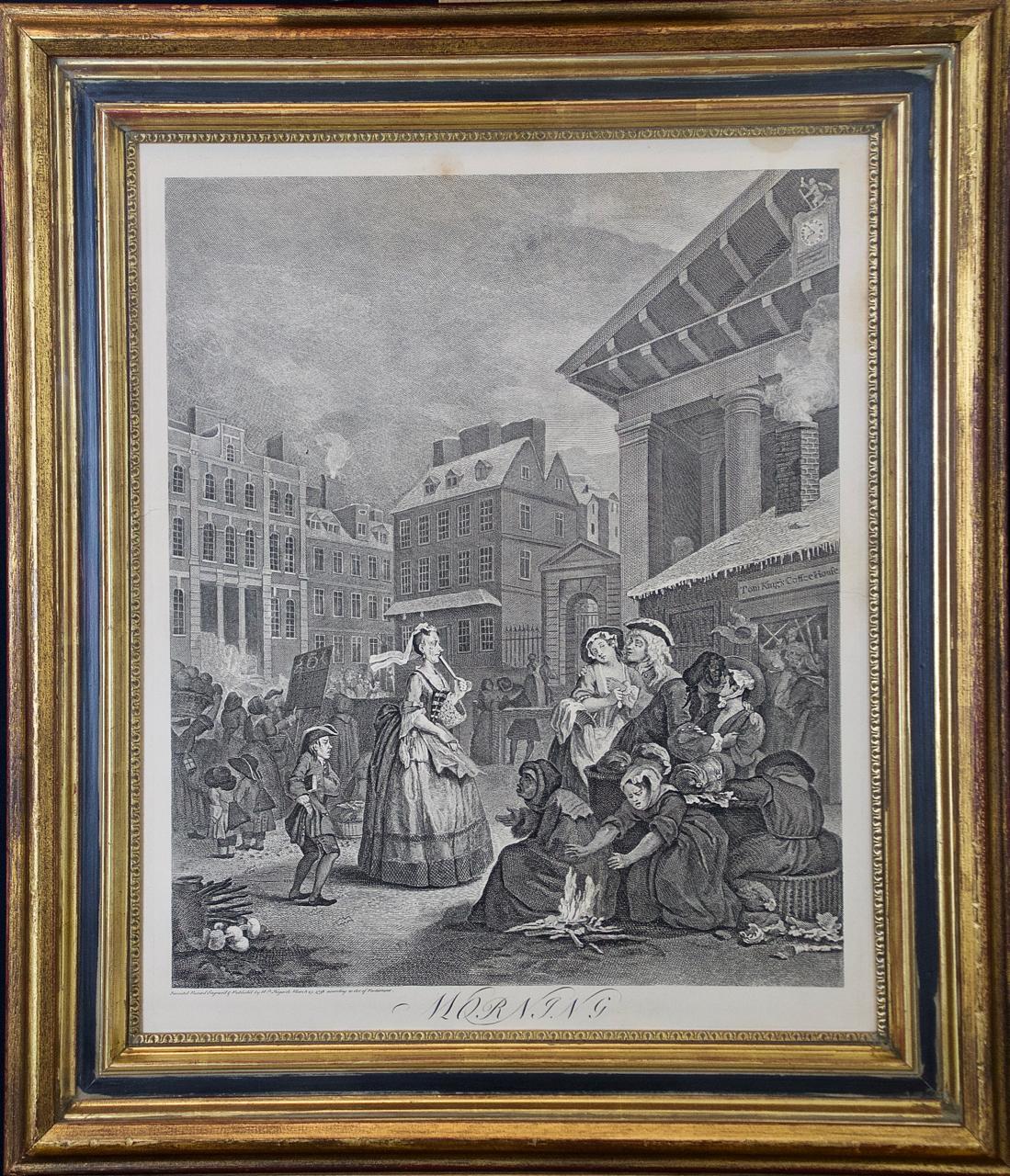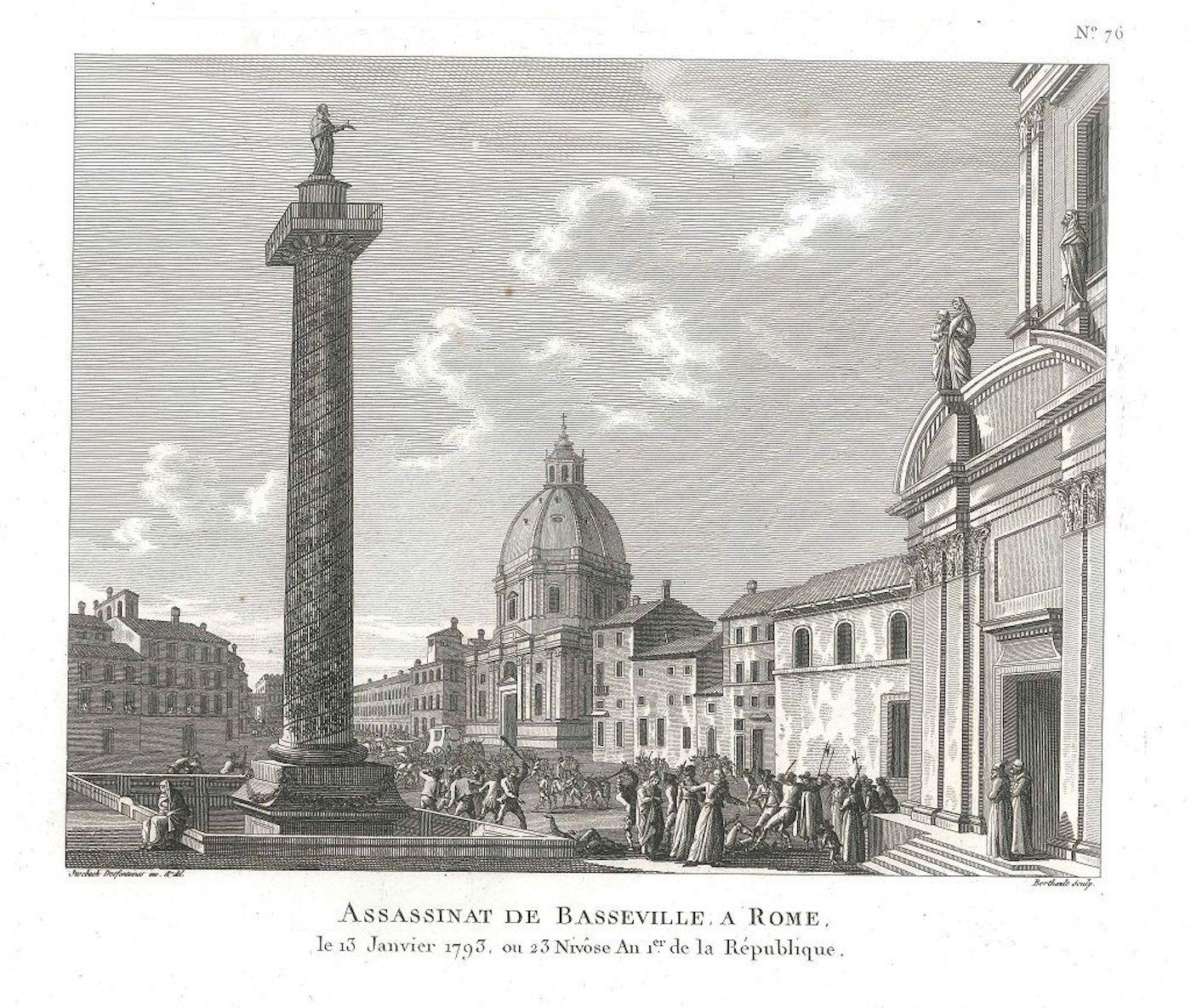Items Similar to Suite of 12 Views of Italy
Want more images or videos?
Request additional images or videos from the seller
1 of 7
Franz Weirotter Suite of 12 Views of Italy1759
1759
About the Item
Franz Weirotter (1730-1771), Suite of 12 Views of Italy, etchings, 1759 [most signed in the plate by Weirotter]. Reference: Nagel 5. 10 printed in pairs on one sheet; one on a smaller sheet (still with margins), and the larger frontispiece on a single sheet. In generally satisfactory condition, browning toward the outer edge of the sheets, occasional foxing, soiling or staining, some other defects affecting outer edges but not the images. Each of the paired compositions about 6 1/2 x 8 1/4 inches on sheets 16 3/4 x 10 3/8; the frontispiece 7 1/4 x 10 5/8 on a sheet 16 3/4 x 10 3/8 inches. All on laid paper, most with a Bunch of Grapes watermark.
Very good/fine impressions; the impression of Viterbo possibly a proof before the signature (and printed with some ink/soiling); the rest with the Weirotter signature clearly printed.
Although these views were made in Rome or its outskirts, Tivoli, Viterbo, etc., they are not generally of well-known monuments or vistas but rather portraits of the Italian countryside, often depicting relatively modest structures with nearby ruins, and generally with people busily engaged in fishing, talking, preparing food, or otherwise engaged.
Weirotter was one of the most distinguished of the German 18th Century landscape etchers. Although many of these printmakers specialized in reproducing the work of others, Weirotter tended to create original compositions for his prints. The 12 plates in this set are original Wierotter compositions, although they are remindful of the work of 17th Century Dutch artists such as Jan van Goyen, Pieter Molyn, or Jacob van Ruisdael. Hind noted of Weirotter that he was “most successful when he keeps to plates of the small dimensions, to which his delicate and clearly etched line is fitted.”
- Creator:Franz Weirotter (1730 - 1771, German)
- Creation Year:1759
- Medium:
- Movement & Style:
- Period:1750-1759
- Condition:Condition ok but with minor defects as described.
- Gallery Location:New York, NY
- Reference Number:1stDibs: LU51531541503
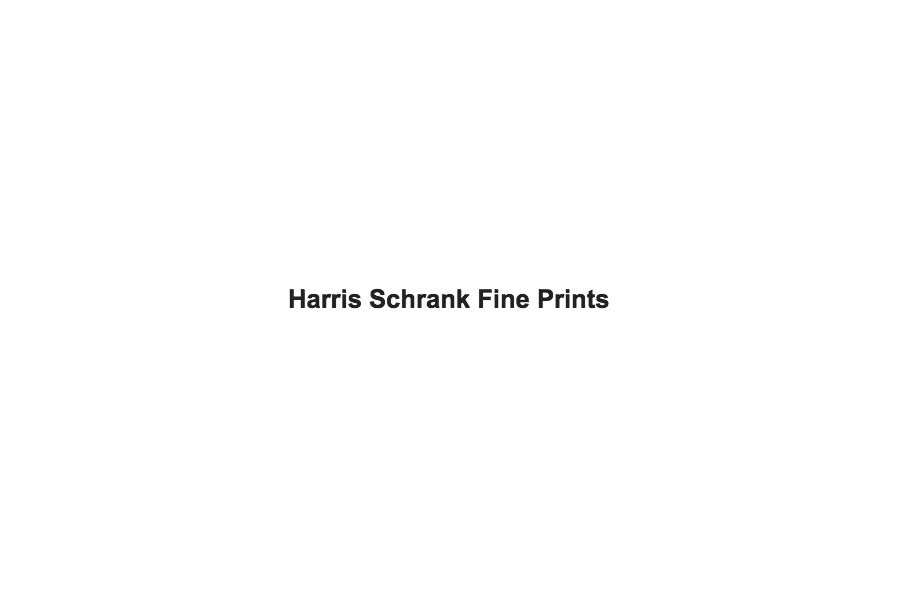
About the Seller
4.9
Recognized Seller
These prestigious sellers are industry leaders and represent the highest echelon for item quality and design.
Established in 2000
1stDibs seller since 2016
99 sales on 1stDibs
Typical response time: 3 hours
Associations
International Fine Print Dealers Association
- ShippingRetrieving quote...Ships From: New York, NY
- Return PolicyA return for this item may be initiated within 7 days of delivery.
More From This SellerView All
- The AnglersBy Adriaen van OstadeLocated in New York, NYAdriaen Van Ostade (1610-1685) etching The Anglers, circa 1647, Godefry 26, Bartsch 26. Very good condition, with small (1/2 inch) margins, on cream laid paper, archival mounting. 4 ...Category
1640s Old Masters Landscape Prints
MaterialsEtching
- The AnglersBy Adriaen van OstadeLocated in New York, NYADRIAEN VAN OSTADE (1610-1685) The Anglers etching, circa 1647-53, on laid paper, without watermark, a very fine impression of the rare third/ fourth state (of seven), printing with a light plate tone, with traces of burr on the bridge and elsewhere and fine wiping marks, with narrow margins, in very good condition. References: Bartsch, Hollstein, Godefroy 26, plate 113 x 166 mm., sheet 116 x 169 mm. Provenance: Richard Fisher...Category
1640s Old Masters Landscape Prints
MaterialsEtching
- Bridge, AmsterdamBy James Abbott McNeill WhistlerLocated in New York, NYJames McNeill Whistler (1834-1903), Bridge, Amsterdam, etching, 1889, printed in brown ink on thin laid paper, signed with the butterfly on the tab and annotated “imp”, also signed with the butterfly on the verso and numbered 11. References: Kennedy 409, Glasgow 447, fifth state (of 5). In very good condition (slight nicks at edges), trimmed by the artist on the plate mark apart from the tab, 6 1/2 x 9 1/2 inches. Provenance: Vivian and Meyer P. Potamkin, Philadelphia; sale, Sotheby’s, New York, May 11, 1989, lot 302 Samuel Josefowitz, Pully, Switzerland A very fine, shimmering impression of this great rarity. This impression is included in the Glasgow inventory, ID number K4090301; only about 11 lifetime impressions in all states are known (three were also printed posthumously by Nathaniel Sparks...Category
1880s Impressionist Landscape Prints
MaterialsEtching
- The Mill, Amsterdam, 1889By James Abbott McNeill WhistlerLocated in New York, NYJames Whistler (1834-1903), The Mill, 1889, etching and drypoint, signed in pencil with the butterfly on the tab and inscribed “imp”, and inscribed “first state” (twice) and annotated “Wunderlich” and signed again with the butterfly verso. Reference: Kennedy 413, first state (of 5). Glasgow 457, second state (of 6; see discussion below) (cf. Margaret F. MacDonald, Grischka Petri, Meg Hausberg, and Joanna Meacock, James McNeill Whistler: The Etchings, a catalogue raisonné, University of Glasgow, 2011) On laid paper, in very good condition, trimmed just outside of the platemark all around except for the tab by the artist, 6 1/4 x 9 3/8 inches. A very fine impression of this great rarity, printed in black/brown ink with a slight veil of plate tone. provenance: H. Wunderlich & Co., New York Louis B. Dailey, New York (Lugt 4500) sale, Sotheby’s, New York, October 31, 2003, lot 69 literature; Neue Lagerliste 122: James McNeill Whistler – Etchings...Category
1880s Impressionist Landscape Prints
MaterialsDrypoint, Etching
- J.H. Woods’ Fruit Shop, ChelseaBy James Abbott McNeill WhistlerLocated in New York, NYJames Whistler (1834-1903), J.H. Woods’ Fruit Shop, Chelsea, etching and drypoint, 1887-88. Signed with the butterfly on the tab and annotated “imp,” also signed with the butterfly in pencil verso and numbered “1”. References: Kennedy 265 second state (of 2), Glasgow 327 second state (of 4). Trimmed by the artist around the plate mark except for the tab, in excellent condition. Printed in black ink on ivory laid paper, 3 3/4 x 5 1/8 inches. A fine impression of this great rarity; the print was never published. Glasgow accounts for four impressions. watermark: partial arms of Amsterdam(cf. Spink/Stratis/Tedeschi, watermark nos. 12ff.) This is before the third state in which heavy shading was added around the woman at the center, and the heads of figures at right and left of the figure are defined. In Glasgow’s fourth state the shading and the figure were removed; no impression is known of this state, but the state is inferred from the cancelled plate. According to Glasgow “Joseph Henry Wood had a greengrocer’s shop at 1 Park Walk...Category
1880s Impressionist Landscape Prints
MaterialsEtching, Drypoint
- Brooklyn Bridge No. 6 (Swaying)By John MarinLocated in New York, NYJohn Marin (1870-1953), Brooklyn Bridge No. 6 (Swaying), 1913, Etching. Z112. Edition c. 12 (Steiglitz); 1924, unknown but small (New Republic). Signed in pencil. Signed and dated...Category
1910s Cubist Landscape Prints
MaterialsEtching
You May Also Like
- Fabricius (Ponte Cestio) Bridge : Framed 18th C. Piranesi Architectural EtchingBy Giovanni Battista PiranesiLocated in Alamo, CAThis framed 18th century etching by Giovanni Battista Piranesi is entitled "Dimostransi nella Tav. presente la Pianta, ed Elevazione del Ponte, oggi detto Quattro Capi egli è antichissimo, e chiamavasi Fabrizio da L. Fabrizio Presid. delle Strade, che lo fabbrico' nel fine della Repubblica. "(The Plan and Elevation of the Bridge, today called Quattro Capi. The architect is very ancient, and was called Fabrizio da L. Fabrizio Presid. delle Strade, who built it at the end of the Republic). This is plate 18 in volume 4 of Piranesi's "Le antichita romane opera di Giambatista Piranesi architetto veneziano" (Roman antiquities by Giambatista Piranesi Venetian architect). It was published in Rome in 1756-1757. This etching depicts the plan and elevation of the bridge now called the Ponte dei Quattoro Capi or Ponte Cestio (Bridge of the Four Heads), which in antiquity was called the Bridge of Fabricius after L. Fabricius, the Superintendant of the Streets who built it at the end of the Republic, around 62 BC. It was also been known in the Middle Ages as ‘Ponte Giudeo’ (Bridge of the Jews). The bridge crossed from the left bank or northeast side of the Tiber River to Tiber Island...Category
1750s Old Masters Landscape Prints
MaterialsEtching
- 18th Century Etching of "Chiesa di S. Lucia" in Rome by Giuseppe VasiBy Giuseppe VasiLocated in Alamo, CAThis 18th century etching is entitled "Chiesa di S. Lucia alle Botteghe Oscure" by Giuseppe Vasi was published in Rome in 1747 in Vasi's 'Magnificenze di Roma Antica e Moderna', whic...Category
Mid-18th Century Old Masters Landscape Prints
MaterialsEtching
- Piranesi 18th C. Etching "Reliquiae Theartri Pompejani" an Ancient Roman TheaterBy Giovanni Battista PiranesiLocated in Alamo, CAThis a framed Giovanni Battista Piranesi (1720-1778) etching entitled "Reliquiae Theartri Pompejani" (Remains of the Theatre of Pompey) from "Il Campo Marzio dell'Antica Roma" (The C...Category
Mid-18th Century Old Masters Landscape Prints
MaterialsEtching
- Four Framed Hogarth Engravings "Four Times of the Day"By William HogarthLocated in Alamo, CAThe four plates in this "Four Times of the Day" set were created utilizing both engraving and etching techniques by William Hogarth in 1738. Hogarth's original copper plates were refurbished where needed by James Heath and these engravings were republished in London in 1822 by Braddock, Cradock & Joy. This was the last time Hogarth's original copper plates were used for printing. Most were melted down during World War I for the construction of bombs. Printed upon early nineteenth century wove paper and with large, full margins as published by William Heath in 1822. The inscription below each print reads "Invented Painted & Engraved by Wm. Hogarth & Publish'd March 25. 1738 according to Act of Parliament". These large folio sized "Four Times of the Day" engravings/etchings are presented in complex gold-colored wood frames with black bands and scalloped gold inner trim. A majority of each thick impressive frame is covered with glass applied near the outer edge. Each frame measures 25.75" high, 22.25" wide and 1.88" deep. There are a few small dents in the edge of these frames, which are otherwise in very good condition. "Morning" has two focal areas of discoloration in the upper margin and some discoloration in the right margin, a short tear in the left margin and a short tear or crease in the right margin. "Noon" has a spot in the upper margin that extends into the upper image, but it is otherwise in very good condition. "Evening" has a faint spot in the upper margin, but it is otherwise in very good condition. "Night" is in excellent condition. The "Four Times of the Day" series is in the collection of many major museums, including: The British Museum, The Metropolitan Museum of Art, The Tate Museum, The Chicago Art Institute and The Victoria and Albert Museum. Through this series Hogarth is portraying early 18th century London street life at "Four Times of the Day". His characters are exhibiting their personalities, quircks, strange activities, but he also wants to draw attention the disparities between the wealthy aristocracy and the common working class. Plate 1, "Morning" depicts morning in Covent Garden in the winter in front of Tom King...Category
Mid-18th Century Old Masters Landscape Prints
MaterialsEngraving, Etching
- Assassinat de Basseville à Rome - Original Etching by P.G. Berthault - 1793By Pierre Gabriel BerthaultLocated in Roma, ITAssassinat De Basseville à Rome is an original black and white etching realized by Pierre Gabriel Berthault, after Jacques François Joseph Swebach-Desfontaines in 1793. Title with caption on plate on the lower center: "Assassinat de Basseville, à Rome/ le 13 Janvier 1793, ou 23 Nivose An Ier de la République". Below the image on the lower margin, "Swebach Desfontaines onv. et del. / Berthault sculp." is etched on plate. This modern artwork is numbered "N. 76", because it is from the series Les Tableaux historiques de la Révolution française. As a matter of fact, Pierre-Gabriel Berthault is well-known for having engraved plates from this collection with the collaboration of the engraver Jean Duplessis-Bertaux. A work - hanging in the balance between news and history - with illustrations of salient or minimal events occurred during the French Revolution. As a celebration of the new ideals of brotherhood, justice, and equality, Les Tableaux immediately became a point of reference for journalism at the time. Of traditional cut, namely showing a view with many human figures, the engraving simplified the lines to be immediately readable for the general public. In our specific case, this original print represents the murder of Hugou de Bassville or Basseville (7 February, 1743 – 13 January, 1793), a French journalist and diplomatist, and protector of the radical Jacobins in Rome. In excellent conditions, except for a usual yellowing of the paper on the edges and a light trace of oxidations on the lower and right margins, beyond the marginal line of the matrix. Pierre-Gabriel Berthault (Saint-Maur-des-Fossés, 1737 - Paris, 1831) was a French master who made engravings from drawings by Jean-Claude Richard de Saint-Non (known as the Abbot of Saint-Non) and from paintings by Louis François Cassas. He depicted many views of Italy and created the collections Voyage à Naples and Voyage pittoresque de la Syrie, de la Palestine et de la basse-Egypte. Before the French Revolution, he was famous for being the author of the Vues intérieures de Paris and for tables with architectural elevations.Category
1790s Old Masters Landscape Prints
MaterialsEtching
- The Passengers - Original Etching by A. M. de Ghuy - 1775Located in Roma, ITThe Passenger is an original artwork realized by Antoine de Marcenay de Ghuy in 1775. Original etching on paper. Titled on the lower margin at the center. The artwork is glued on ca...Category
1770s Old Masters Landscape Prints
MaterialsEtching
